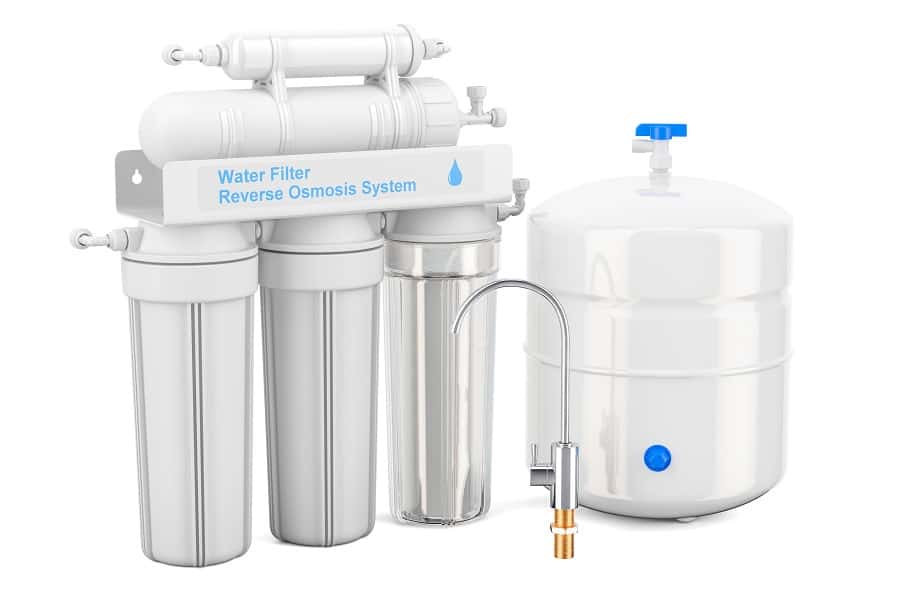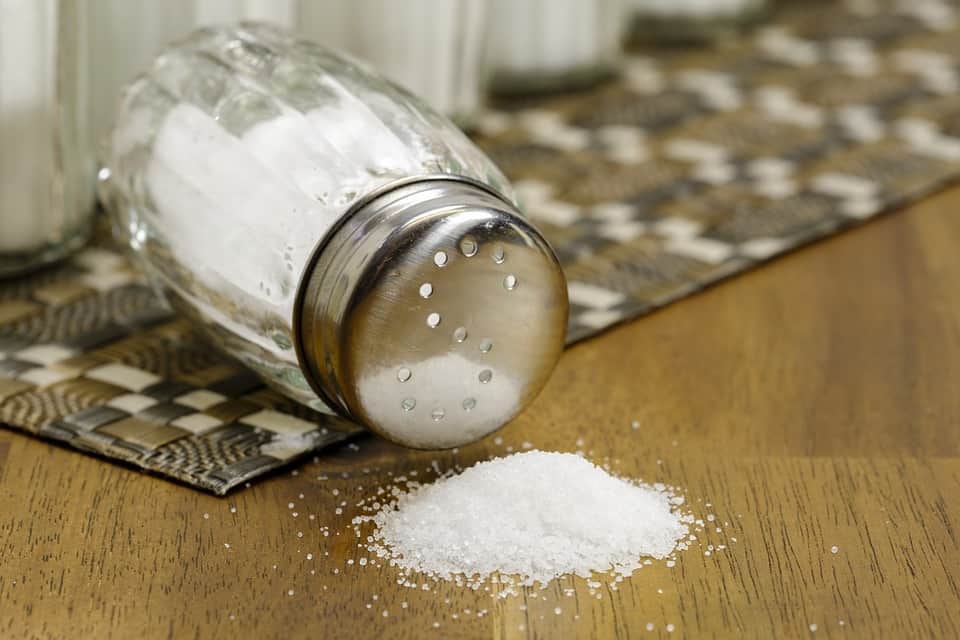UPDATED: September 5, 2022
This is a great question! Most people do not really understand just what their water softener does, and what benefits a reverse osmosis system can give you. There is no real answer to this question because they are two completely different systems that do very different things. But they are a great combination.
Having a water softener does not mean that you also need to have a reverse osmosis system to make the water drinkable. But if your water is high in sodium due to the water softener, then a reverse osmosis drinking water system would be highly recommended.
It’s easy to get these two types of water systems confused as they both remove things from water. A water softener does just what it sounds like it should do. It softens water by removing hardness from it.
A reverse osmosis system is a little more complicated though. Yes, it does remove things from water and it can even remove hardness from water, but is it a water softener? Absolutely not!
Not only is a reverse osmosis system not a water softener, but it is a filter, and a water softener is not.

If there is a lot of salt in your water, then you should have a reverse osmosis drinking water system.

A reverse osmosis system passes water through a pre-filter that will remove any sediment in the water. This is only for larger particles such as dirt and grit, the finer dissolved solids will be filtered out by the reverse osmosis membrane.
Although some reverse osmosis systems have several extra filters (or stages) on their systems, the next primary filtering stage is the reverse osmosis membrane. This is where the primary function of the whole system takes place.
At this stage in the system, the water gets forced through a semi-permeable membrane, which is essentially a super-fine filter that allows the water to pass through but rejects the dissolved solids and discharges them to waste.
Calcium and magnesium which are the leading minerals that contribute to hardness in water can be removed by the process of reverse osmosis, but in doing so, the calcium and magnesium ions will form a layer on the membrane that will inhibit its ability to remove the dissolved solids that it is intended to and essentially ruin the membrane.
While regular dissolved salts will not pass through the membrane and be discarded, hardness ions will cling to the membrane, causing scaling and blocking the holes that allow the water to pass through.
So, do I need a water softener or just reverse osmosis?
If you have a reverse osmosis system, it is very important that you have a water softener to remove any hardness or iron that may be in the water.
Hardness and iron will ruin a reverse osmosis membrane and will quickly clog the system pre-filter, so having a water softener will help to protect your reverse osmosis system and prolong the membranes life.
But doesn’t a water softener filter out hardness?
Not exactly! A water softener removes hardness, but it does not remove it by passing the water through a filter. A water softener removes hardness through a process called ion exchange.
The reason that water can feel hard is that it contains minerals like calcium and magnesium, which are considered to be hard minerals. So to soften the water we need to remove these hard minerals from the water.
But simply stripping these minerals from the water will leave the water very aggressive. This means that the water will be corrosive and wanting to absorb other minerals because water does not like to be without minerals in it.
This is because water is considered to be a universal solvent. Water can dissolve and absorb many kinds of minerals and other deposits, making it naturally absorb minerals from whatever is available, whenever other minerals have been taken from it.
That’s why the process of ion exchange works so well and is more practical than other water softening methods. After the water softener removes the hardness from the water, we can use ordinary salt ions to in a sense, clean the water softener, so it can continue to remove hardness.
I still don’t get just how a water softener works.
Picture a shallow stream, with the water running over the pebbles and rocks in the stream’s bed. Now visualize leaves floating on top of the water, and as the leaves go past the pebbles and rocks they are attracted to the rocks and cling tightly to them.
This is similar to the hardness in the water clinging to the water softening resin in a water softener. So the leaves enter this area where they come into contact with the pebbles and rocks that hold the leaves and let the water continue without any leaves in it.
But eventually, there are just too many leaves clinging to the rocks. At some point, the pebbles and rocks no longer have any surface area left for any more leaves to cling to.
This is where the brine solution comes in to play on a water softener.
We open the flood gates to the stream and let a strong flow of salty ocean water pour down the stream, rinsing the leaves off of the pebbles and rocks and leaving a tiny layer of saltwater behind.
This is a reasonably good visual of what is happening inside a water softener as hard water passes through it. The hardness is not removed by filtering but by a process called ion exchange, the exchanging of hardness ions for sodium ions.
Water softening means water conditioning!
What are the benefits of a water softener?
No more hard water stains – By removing the hard minerals in water that can cause corrosion and build-up on your fixtures and appliances, you will extend the life of your fixtures and appliances and even keep your hot water heater working more efficiently.
Less wasted soap – Since soap and detergents work better with soft water, you will need less to get your clothes and house clean.
Clothes will last longer – Soft water will not cause your clothes to fade and fray like hard water can, and will leave your laundry cleaner than with hard water. By needing less soap to clean your laundry, you will save money on expensive laundry detergent.
Reverse osmosis means water filtering!
What are the benefits of a reverse osmosis drinking water system?
Pure tasting water – Weather you use water for your morning coffee or tea, or simply enjoy clean tasting water on its own, a reverse osmosis drinking water system provides water that is up to 98% purer than before.
Chemical-free purification – Unlike some other forms of water purification, a reverse osmosis system uses a semi-permeable membrane to filter, not chemically treat your drinking water.
Removal of odors and chemicals – Reverse osmosis drinking water systems use a carbon filter to help remove odors and chemicals like chlorine from the water.
Not sure about how often you should be changing your reverse osmosis filters? Check out my article on “How Often YOU Should Change YOUR Reverse Osmosis Filters“.
So, the answer to the question could be yes or no.
If you have hard water, you should have a softener to protect your plumbing from hardness build-up, corrosion of your plumbing fixtures, and hard water spots on your dishes, and to improve the cleaning ability of any soaps or detergents that you use.
If you have hard water plus a high amount of sodium in your water, you should have a water softener and a reverse osmosis system to remove the hardness from the water and then remove the excess sodium, making the water healthier for you to drink.
As you can now see, a water softener is very different from a reverse osmosis system. Both are very beneficial water treatment systems, but hardly interchangeable.
You can have a water softener and not have a reverse osmosis drinking water system, but if you have a reverse osmosis system, be sure the water going to it is soft and iron-free. And be sure to change your filters as recommended by the manufacturer.
Related questions:
Will reverse osmosis remove hardness from water? The process of reverse osmosis removes many things from water, including hardness. But the hard minerals tend to collect on the reverse osmosis membrane and inhibit its ability to filter out the dissolved solids that the system is intended for.
I recommend that the water going into a reverse osmosis system be soft and iron-free. This will extend the life of the membrane and ensure that the system works as it should.
How does a reverse osmosis system remove dissolved solids? A reverse osmosis drinking water system uses a semi-permeable membrane to reject the dissolved solids in the water and flush them away to waste while allowing the rest of the water to flow through.
Much like a leaf blowing onto a window with a screen on it. The air passes freely through the screen in both directions, but the leaf is stopped by the screen and then falls to the ground.

